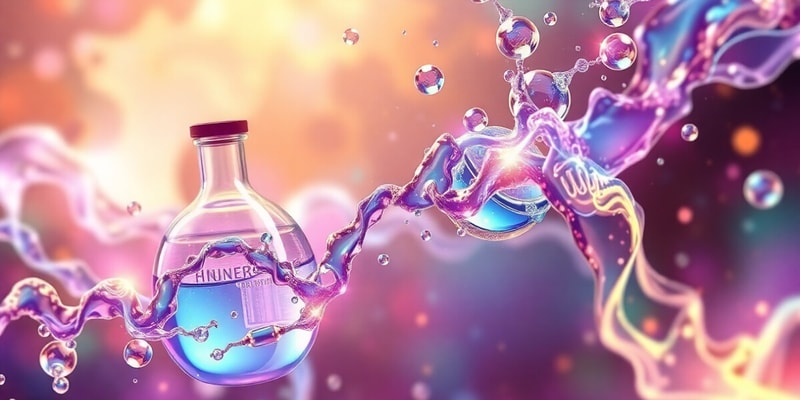Podcast
Questions and Answers
What is the primary function of buffer solutions in a Chemical context?
What is the primary function of buffer solutions in a Chemical context?
Which pair of substances represents a common buffer system?
Which pair of substances represents a common buffer system?
What happens to the pH of a buffer solution when a strong acid is added?
What happens to the pH of a buffer solution when a strong acid is added?
In the Henderson-Hasselbalch equation, which value is used to calculate the ratio of the buffer components?
In the Henderson-Hasselbalch equation, which value is used to calculate the ratio of the buffer components?
Signup and view all the answers
What is the effect of adding a small amount of a strong acid, such as HNO3, to a buffer solution consisting of AcOH and AcONa?
What is the effect of adding a small amount of a strong acid, such as HNO3, to a buffer solution consisting of AcOH and AcONa?
Signup and view all the answers
Which of the following statements describes the behavior of a buffer solution with a pH close to its pKa?
Which of the following statements describes the behavior of a buffer solution with a pH close to its pKa?
Signup and view all the answers
What is the consequence of adding a strong acid in an amount equal to the concentration of a buffer solution?
What is the consequence of adding a strong acid in an amount equal to the concentration of a buffer solution?
Signup and view all the answers
For a buffer system based on TRIS, what is the pKa value of its conjugate acid TRIS-H+?
For a buffer system based on TRIS, what is the pKa value of its conjugate acid TRIS-H+?
Signup and view all the answers
Which buffers are effective in the pH range of 6-8?
Which buffers are effective in the pH range of 6-8?
Signup and view all the answers
In a buffer solution with a concentration of 0.045 mol L-1 for both AcOH and AcONa, what is the effect of adding 1.0 × 10−4 mol of HNO3?
In a buffer solution with a concentration of 0.045 mol L-1 for both AcOH and AcONa, what is the effect of adding 1.0 × 10−4 mol of HNO3?
Signup and view all the answers
What is the concentration of TRIS-H+ after adding 0.005 M H+ to the initial 0.1 M TRIS solution?
What is the concentration of TRIS-H+ after adding 0.005 M H+ to the initial 0.1 M TRIS solution?
Signup and view all the answers
Which formula represents the relationship between [TRIS] and [TRIS-H+] at pH 8.0 for a 0.1 M solution?
Which formula represents the relationship between [TRIS] and [TRIS-H+] at pH 8.0 for a 0.1 M solution?
Signup and view all the answers
If the pKa of benzoic acid is 4.19, what is the necessary ratio of benzoic acid to benzoate anion to achieve a pH of 3.5?
If the pKa of benzoic acid is 4.19, what is the necessary ratio of benzoic acid to benzoate anion to achieve a pH of 3.5?
Signup and view all the answers
What is the calculated pH after the addition of acid to a 0.02 M TRIS solution, given the concentrations after addition are [TRIS] = 0.004 M and [TRIS-H+] = 0.016 M?
What is the calculated pH after the addition of acid to a 0.02 M TRIS solution, given the concentrations after addition are [TRIS] = 0.004 M and [TRIS-H+] = 0.016 M?
Signup and view all the answers
What effect does increasing the concentration of a buffer have on its effectiveness?
What effect does increasing the concentration of a buffer have on its effectiveness?
Signup and view all the answers
What is the correct Henderson-Hasselbalch equation for the dissociation of NaHCO3 acting as an acid in water?
What is the correct Henderson-Hasselbalch equation for the dissociation of NaHCO3 acting as an acid in water?
Signup and view all the answers
Which of the following factors can affect the behavior of ions in solutions?
Which of the following factors can affect the behavior of ions in solutions?
Signup and view all the answers
In the context of buffer solutions, what does the term 'real behavior' refer to?
In the context of buffer solutions, what does the term 'real behavior' refer to?
Signup and view all the answers
Given the concentration relationship [TRIS]/[TRIS-H+] = 0.83, how would you express [TRIS] if [TRIS-H+] is 0.055 M?
Given the concentration relationship [TRIS]/[TRIS-H+] = 0.83, how would you express [TRIS] if [TRIS-H+] is 0.055 M?
Signup and view all the answers
When 0.005 M H+ is added to a 0.02 M TRIS solution, what does the final concentration of TRIS become?
When 0.005 M H+ is added to a 0.02 M TRIS solution, what does the final concentration of TRIS become?
Signup and view all the answers
What equation is used to calculate the activity of component i in a solution?
What equation is used to calculate the activity of component i in a solution?
Signup and view all the answers
How does ionic strength I depend on the characteristics of ions in solution?
How does ionic strength I depend on the characteristics of ions in solution?
Signup and view all the answers
In the Debye Huckel Limiting Law, what does the constant A represent?
In the Debye Huckel Limiting Law, what does the constant A represent?
Signup and view all the answers
What is the mean activity coefficient $
\gamma_±$ calculated for a 0.1 M Na3PO4 solution?
What is the mean activity coefficient $ \gamma_±$ calculated for a 0.1 M Na3PO4 solution?
Signup and view all the answers
What represents the mean ionic concentration [±] for Na3PO4 when fully dissociated?
What represents the mean ionic concentration [±] for Na3PO4 when fully dissociated?
Signup and view all the answers
Which equation represents the relationship between pKa, pKb, and pKw?
Which equation represents the relationship between pKa, pKb, and pKw?
Signup and view all the answers
What is the primary purpose of calculating the activities of ions in solution?
What is the primary purpose of calculating the activities of ions in solution?
Signup and view all the answers
When determining the mean activity a± for Na3PO4, the value of [±] was found to be what?
When determining the mean activity a± for Na3PO4, the value of [±] was found to be what?
Signup and view all the answers
Which of the following ions would contribute to a higher ionic strength in a solution?
Which of the following ions would contribute to a higher ionic strength in a solution?
Signup and view all the answers
In the context of ionic solutions, what does the term 'activity' specifically refer to?
In the context of ionic solutions, what does the term 'activity' specifically refer to?
Signup and view all the answers
Study Notes
Henderson-Hasselbalch equations
- Relates pH, pKa and acid/base concentrations.
- Can be used for bases by using the pKa of the conjugate acid.
Buffer solutions
- A solution of a weak acid and its salt (conjugate base).
- Or a weak base and its salt (conjugate acid).
- Example: Acetic acid/sodium acetate.
- Acetic acid is weakly dissociated (pKa 4.76)
- Sodium acetate is fully dissociated.
Buffering effect
- Addition of hydroxide ions (OH-) is neutralised by acetic acid (AcOH)
- Addition of hydronium ions (H3O+) is neutralised by acetate ions (AcO-).
- Example: 0.045 mol L-1 solution of AcOH and 0.045 mol L-1 solution of AcONa
- Addition of 1.0 × 10−4 mol HNO3 to 2.25 × 10−3 mol of both AcOH and AcONa.
- AcO- + H+ → AcOH
- [AcO-] = (2.25 × 10−3 − 1.0 × 10−4 ) = 2.15 × 10−3 mol
- [AcOH] = (2.25 × 10−3 + 1.0 × 10−4 ) = 2.35 × 10−3 mol
- The pH of the solution is reduced by the addition of acid, but not greatly, from 4.76 to 4.72.
Common buffers
- NaH2PO4 / Na2HPO4 pH range 6-8
- KH2PO4 / K2HPO4 pH range 6-8
- (HOCH2)3CNH2 / (HOCH2)3CNH3+ (TRIS) pH range 7-9
- HEPES pH range 6.8 – 8.2
Worked example: TRIS / TRIS-H+ Buffer
- pKa of TRIS-H+ is 8.08.
- The TRIS/TRIS-H+ ratio at pH 8.0 is:
- 𝑇𝑅𝐼𝑆/𝑇𝑅𝐼𝑆 − 𝐻 + = 0.83
Addition of acid to 0.1 M TRIS/TRIS-H+
- 0.1 M = [TRIS] + [TRIS-H+]
- [TRIS]/[TRIS-H+] = 0.83 at pH 8.0
- [TRIS] = 0.83[TRIS-H+]; 0.1 M = 1.83[TRIS-H+]
- [TRIS-H+] = 0.055 M; [TRIS] = 0.045 M
- Add 0.005 M H+ (of a strong acid)
- [TRIS] = 0.040 M; [TRIS-H+] = 0.060 M
- 𝑝𝐻 = 8.08 − log10 (0.06/0.04) = 7.9
Addition of acid to 0.02 M TRIS/TRIS-H+
- 0.02 M = [TRIS] + [TRIS-H+]
- [TRIS]/[TRIS-H+] = 0.83 at pH 8.0
- [TRIS] = 0.009 M; [TRIS-H+] = 0.011 M
- Add 0.005 M H+
- [TRIS] = 0.004 M; [TRIS-H+] = 0.016 M
- 𝑝𝐻 = 8.08 − log10 (0.016/0.004) = 7.48
- The buffer is more effective at higher concentration.
Ions in solution
- Behaviour of ions in solution is affected by many factors:
- Degree of ionisation
- Extent of solvation
- Ion-ion vs. ion-solvent interactions
- External fields
- Other phenomena
- Pharmaceutical solutions require consideration of the effect of dissolved ions.
- Need to consider real (rather than ideal) behaviour, i.e. activity rather than concentration.
Activity of ions in solution
- 𝜇𝑖 = 𝜇𝑖° + 𝑅𝑇 ln 𝑎𝑖
- 𝑎𝑖 = activity of component i
- 𝑎𝑖 = 𝛾𝑖[𝑖]
- 𝛾𝑖 = activity coefficient of component i
- 𝜇𝑖 = 𝜇𝑖° + 𝑅𝑇 ln 𝑖 + 𝑅𝑇 ln 𝛾𝑖
- Quantifies deviations from ideality.
Debye Huckel Limiting Law
- log10 𝛾± = −𝐴𝑧+ 𝑧− 𝐼
- A is a constant (= 0.509 for water at 25 ◦C)
- z+ and z- are the charges of the +ve and –ve ions
- ‘±’ implies mean value for both ions
- I is the Ionic Strength
Ionic Strength (I)
- Depends on the number of cations and anions in solutions.
- Quantifies the ionic field generated by a system of ions in solution.
- 𝐼 = ½ ∑𝑖 𝑧𝑖2
Worked example: Ionic strength and mean activity coefficient of 0.1 M Na3PO4
- Na3PO4; fully dissociated in water to 3Na+ and PO43-
- zNa = 1; [Na] = 3 x 0.1 M
- zPO4 = 3; [PO4] = 0.1 M
- I = ½{[(0.3M)12] + [(0.1M)32]} = 0.60 M
- Log10ϒ± = −(0.509)(1)(3)√(0.6) = − 1.183
- ϒ± = 0.066
Mean activity of 0.1 M Na3PO4
- a± = ϒ±[±] ([±] = mean ionic concentration of salt)
- [±] = n√{([+])n+([-])n-} n = n+ + n-
- For Na3PO4, [±] = 4√{(0.3)3(0.1)} = 0.228 M
- a± (Na3PO4) = (0.066)(0.228 M) = 0.015 M
- There is a significant difference between ionic activity and concentration.
- Activities determine equilibria for ions in solution.
Ka, Kb and Kw
- AH and A- corresponding acid and conjugate base
- pKa + pKb = pKw
Studying That Suits You
Use AI to generate personalized quizzes and flashcards to suit your learning preferences.
Related Documents
Description
This quiz covers the concepts of buffer solutions and the Henderson-Hasselbalch equation, focusing on their roles in acid-base chemistry. You'll explore the relationship between pH, pKa, and the buffering effects of different solutions, with specific examples such as acetic acid and sodium acetate. Test your understanding of these essential principles of chemistry!




